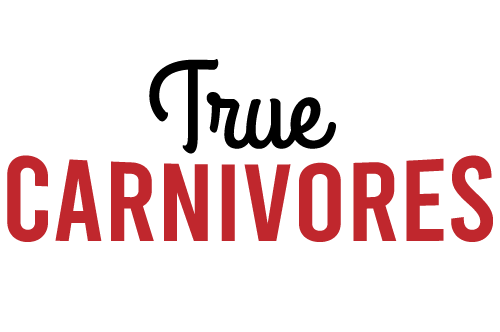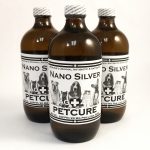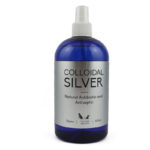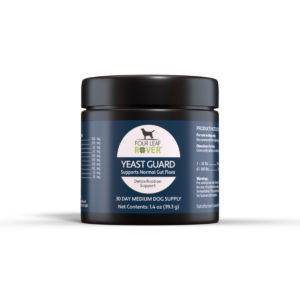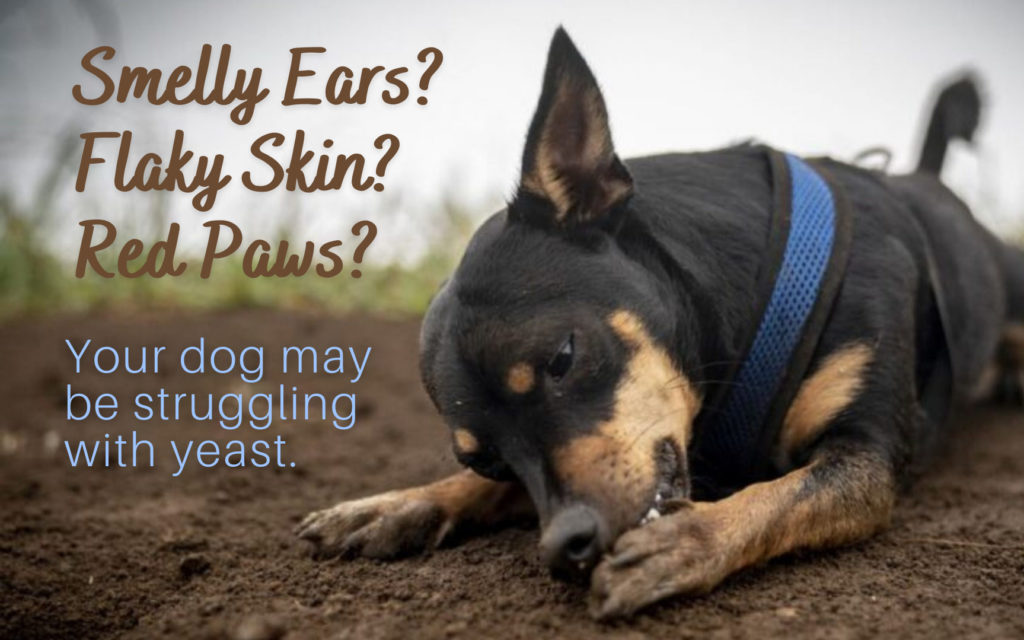
Yeast Infections In Dogs
What is yeast dermatitis?
Yeast dermatitis is caused by the fungus Malassezia pachydermatis. This yeast is normally found on the skin, but its abnormal overgrowth can cause dermatitis, or inflammation of the skin. Yeast dermatitis is a common issue in dogs that can be frustrating to treat, but there are several ways you can treat your dog’s yeast infection at home that can help solve this common cause of itchy skin.
There are also colonies of yeast in the gut, these are Candida albicans. This yeast is kept under control by good bacteria in your dog’s gut. They compete with Candida for food and attachment sites, and this keeps the yeast colonies down, but if yeast is allowed to grow out of control, it can irritate the cells that line your dog’s digestive tract. Normally, these cells have tight junctions between them. This stops harmful bacteria, viruses, and yeast from entering the blood stream from the intestines. But when there is an overgrowth of yeast, this will create inflammation, and this causes the space between the cells lining the intestines to widen. When this happens, yeast and toxic by-products can exit the digestive tract and enter your dog’s bloodstream. This is called leaky gut. We have a blog about leaky gut if you would like more information.
What are the signs my pet has a yeast infection?
Yeast thrives in a moist environment, so for dogs, that can be in places such as the ears, paws, armpit, groin, and even the folds of their face in certain breeds. Watch out for these signs that your dog has an overgrowth of yeast:
- Changes in skin
 color and texture. In the early stages of a yeast infection, the skin begins to turn pink or red. When dealing with chronic yeast infections, the skin may become leathery, thick, and gray or black.
color and texture. In the early stages of a yeast infection, the skin begins to turn pink or red. When dealing with chronic yeast infections, the skin may become leathery, thick, and gray or black.
- Greasy skin. The skin can become greasy or excessively oily.
- Scaly skin. Some dogs may develop scaling, crusting, or flakiness of the skin, similar to dandruff.
- Head shaking and tilting. Because the ears are the most common place for a dog to develop a yeast infection, pay close attention if your dog starts exhibiting these movements.
- Scratching and rubbing. Yeast infections are incredibly itchy, and some dogs will try and scratch the infected area or rub up against the floor, furniture, or another surface to get relief. Incessant licking of the infected area is another way a dog might try and find relief.
- Swelling and warmth. Redness and swelling are the first signs of a yeast infection, but a dog’s symptoms can progress to swelling, warmth, and pain in the infected area.
- Weird smell. Another common sign of yeast infection is a distinct smell, which will likely be your first indicator that your dog has this condition. The smell has been described by dog owners to mimic a musty or cheesy scent.
- Hair loss. For yeast infections in the ear, which can be associated with inflammation, hair loss will occur around the ears.
How does a dog get a yeast infection?
Yeast infections can develop for many reasons. A dog with an underactive immune system can develop yeast overgrowth and infection. An overactive immune system can trigger allergic reactions, which also leads to yeast infections. For some dogs, yeast problems are seasonal, and when the temperature and humidity are high, problems with yeast can occur.
The skin and digestive tract has naturally occurring bacteria and fungi. Under normal circumstances, these don’t cause a problem and are kept under control by the immune system. If conditions change, these bacteria and fungi can grow beyond normal levels and cause an imbalance with the other beneficial bacteria in these areas, leading to an infection.
Opportunistic yeast infections often recur unless the underlying allergy or skin condition is controlled, which is why it’s important to assess your pet’s diet when treating a yeast infection. Has their diet changed recently, are they eating a common allergen such as chicken or beef, are they eating a diet that is high in starches?
Dogs that receive immunosuppressive drugs such as corticosteroids may also be unable to effectively prevent yeast infections, so may develop a chronic yeast infection. Antibiotic treatment can often lead to an overgrowth of yeast as well, as the antibiotics do not discriminate between beneficial and harmful bacteria, leading to an imbalance in the natural skin and gut flora where yeast can easily take over.
How to treat your dog's yeast
You will want to treat your pet’s yeast infection topically as well as internally. Some topical treatments for yeast include:
Cleaning your dog’s ears.
Since the ears are one of the most common areas for a yeast infection, it’s important to keep them clear and clean. Using a dog-ear cleaning solution designed to lower pH levels, gently clean the ear with a soft tissue or cotton ball (do not put Q-tips down into the ear canal). If your dog spends a lot of time in the water, it is important to thoroughly dry their ears each time, as yeast thrives in warm, moist environments.
Keep paws clean and dry.
A dog’s sweat glands are primarily located in the paws, so it’s wise to wipe down after long or vigorous exercise. As the paws come into contact with dirt frequently, it’s another reason to keep them clean. Moisture can get trapped between the toes, especially in longer-haired breeds. Be sure to thoroughly dry between toes and toe pads after cleaning.
Using topicals to treat yeast
Coconut (or MCT) Oil, Apple Cider Vinegar, and Colloidal Silver are all effective topical treatments for yeast. You can use them on itchy ears and paws, and they are pet-safe if your pet gets a chance to lick at the area after application.
Treating Yeast Internally
- Step 1: Stop Feeding The Yeast
Yeast loves to eat sugar. If you remove carbs and sugar from your dog’s diet, you remove the yeast’s food source and can begin to starve it. Carbohydrates are complex chains made up of sugars. When your dog eats them, their body converts them into sugars, and this feeds the yeast.
In the wild, the foods your dog’s ancestors ate contained only about 4% starch, but most commercial pet foods have over ten times that amount. Even grain-free foods have large quantities of potatoes, sweet potatoes, or tapioca and often have just as much starches as other kibble.
We believe that a raw diet is the best option for treating and managing yeast infections in dogs, as raw diets don’t have the large amount of starches that commercial foods contain.
Some dogs may do best with a diet that is higher in fibre, but we can achieve this while keeping the diet low in carbohydrates and starches. Try adding greens, lower-glycemic starches such as squash or pumpkin, and small amounts of berries to your pet’s meals to give them phytonutrients and fibre, while still starving the yeast colonies of the sugars they crave.
- Step 2: Destroy The Yeast Biofilm
Yeast cells have a protective shell made up of several layers. This tough outer shell is called a biofilm and it’s what makes yeast tough to kill. Once this protective biofilm is stripped off, the yeast is no longer protected from immune cells and other beneficial bacteria.
Digestive enzymes are special proteins that help your dog digest his food. They’re also the enemy of yeast as they can digest yeast’s biofilm. Your dog’s body naturally creates its own digestive enzymes, but these enzymes aren’t always effective at breaking down yeast’s biofilm. Additionally, if your dog is on a processed or cooked diet, they will be lacking in enzymes.
It’s important to give your dog digestive enzymes between meals rather than with meals, so you can maximize their effects. Enzymes will also make your dog’s digestive tract more acidic, which makes it less hospitable to both yeast and harmful bacteria. Another benefit to digestive enzymes is that they can help to reduce the symptoms of yeast die-off.
What Is Yeast-Die-Off?
As the yeast begins to die, they release toxic substances. If a large volume of yeast is dying all at once, these toxins can reach a level that created a new set of symptoms in your pet.
The symptoms of yeast die-off can include:
- Diarrhea
- Worsening of symptoms
- Discharge from eyes, nose, skin, and ears.
- Joint soreness
These symptoms should only last a few days to a few weeks, and then your dog should start looking and feeling much better. It is important not to reduce or stop the treatment steps you are taking to treat your dog’s yeast, as this can allow the yeast colonies to begin growing and overtaking again.
If you suspect your dog is having an adverse reaction to yeast die off, you can try these things:
- Give digestive enzymes: They can help quickly digest and eliminate dead yeast cells.
- Give humic/fulvic acid, bentonite clay and chlorella: They can help bind to heavy metals.
Suggested Digestive Enzymes
Four Leaf Rover Digest: 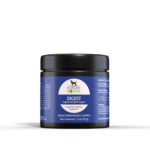 Digest is a natural supply of digestive enzymes and delivers a healthy helping of soil-based probiotics to support the gut.
Digest is a natural supply of digestive enzymes and delivers a healthy helping of soil-based probiotics to support the gut.

Adored Beast Healthy Gut: Helps rebalance and cultivate proper growing conditions for friendly digestive flora destroyed by antibiotics and toxins. Contains digestive enzymes and 14 probiotic strains.
Suggested Humic & Fulvic Acids
 Four Leaf Rover Protect: Soil-based probiotics, probiotic yeast and carefully selected ingredients including humic and fulvic acid. supports dogs daily from exposure to heavy metals and environmental toxins, while supporting proper gut health.
Four Leaf Rover Protect: Soil-based probiotics, probiotic yeast and carefully selected ingredients including humic and fulvic acid. supports dogs daily from exposure to heavy metals and environmental toxins, while supporting proper gut health.
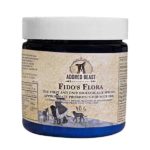 Adored Beast Fido’s Flora: The first biologically species-appropriate probiotics for your dog. This revolutionary product from dogs, for dogs, is a multi-strain probiotic blend featuring powerhouse minerals fulvic and humic acid and prebiotic larch.
Adored Beast Fido’s Flora: The first biologically species-appropriate probiotics for your dog. This revolutionary product from dogs, for dogs, is a multi-strain probiotic blend featuring powerhouse minerals fulvic and humic acid and prebiotic larch.
- Step 3: Supplements To Treat Your Dog’s Yeast
We believe that the best diet for a dog with yeast is a whole food, raw diet, avoiding any starchy carbohydrates. Once you’ve stopped feeding the yeast and you’ve broken up the biofilm, it’s a good idea to add antifungal foods and supplements to your dog’s diet. These are some of the most effective antifungal foods:
Caprylic Acid: This is a medium chain triglyceride (MCT) found in coconut oil. Research shows caprylic acid can directly treat some yeast infections. It’s believed it can destroy Candida by destroying its cell membrane. Ideally, your dog’s caprylic acid would come from MCT oil, as the research done on the benefits of coconut oil were done using MCT oils and not unrefined coconut oil.
Coconut oil is also a poor choice for managing yeast infection in dogs because of its lauric acid content. Lauric acid can promote inflammation in the digestive tract, and digestive inflammation is a key cause of leaky gut. For this reason as well, a good quality MCT oil is a better option for managing yeast than coconut oil.
MCT oil can cause diarrhea in your dog if you give too much, so we recommend you start slowly and work your way up. Try starting with 1/4 tsp for large and medium sized dogs.
Olive Leaf: Like caprylic acid, olive leaf is believed to break down the Candida cell membrane. Its active antifungal substance is oleuropein. Olive leaf has been shown to prevent and manage yeast in multiple studies, so it is a great addition to your pet’s regimen to help fight yeast.
Pau D’Arco: This is a proven antifungal from the rain forests of South America. Pau d’arco contains naphthoquinones, which can kill fungi (as well as parasites and viruses). It also contains lapachol, a substance known to kill yeast.
Goldenseal: Goldenseal contains a compound called berberine. This is an alkaloid that helps the plant defend itself from fungus and bacteria. It’s a well-known antifungal that has been shown to fight yeast in studies. Goldenseal should not be given in pregnant or hypoglycemic dogs and should not be given long-term in large doses.
One product that contains all 4 of these supplements is Four Leaf Rover Yeast Guard
- Step 4: Proactively Control The Yeast
If you switch your dog to a raw diet and reduce the starches they are consuming, you’ll start to starve the harmful yeasts. And now you also have some supplements to help kill the yeast.
For pets that are prone to yeast overgrowth, you will need to create a gut environment that’s not hospitable to yeast. There are a few ways to do this:
Add Probiotics: After you make the gut microbiome a nicer place for beneficial bacteria to live, it’s time to start adding probiotics to your dog’s diet. There are many probiotic supplements you can choose from, and while not all probiotics will fight yeast, these strains have good research behind them:
- Lactobacillus acidophilus
- Lactobacillus casei
- Lactobacillus plantarum
- Lactobacillus reuteri
- Lactobacillus rhamnosus
- Bifidobacterium bifidum
- Bifidobacterium longum
What Are The Best Probiotics For Preventing My Dogs Yeast?
Soil based probiotics (SBOs) are a different class of probiotics. Most bacteria like Lactobacillus and Bifidobacterium are fragile, and are easily destroyed by your dog’s acidic gut. SBOs are spore-forming, which means they can form a protective coating that makes them resistant to heat, acid, and antibiotics. It also makes them more likely to survive the large intestine compared to other probiotic strains.
These soil-based probiotics are proven to help fight yeast overgrowth directly:
are proven to help fight yeast overgrowth directly:
- Bacillus coagulans
- Bacillus subtilus
Pediococcus acidilactici is an additional probiotic that bears special mention. It prevents undigested food from accumulating in the gut and attracting unwanted yeast and bacteria. Another study found that it protects the gut lining from harmful organisms.
Is there a cure for yeast infections in dogs?
While yeast infections can be cured, some dogs are prone to recurrent infections. The best way to prevent a possible occurrence is to take care of your dog’s immune system properly. When you treat the root of the problem, you are not only taking care of the possible yeast infection, but also any other potential skin issues that are a result of problems that originate in the digestive tract.
Information sources:
- https://www.dogsnaturallymagazine.com/itchy-dog-yeast-infection
- https://www.smalldoorvet.com/learning-center/medical/yeast-infections-in-dogs
- https://vcacanada.com/know-your-pet/yeast-dermatitis-in-dogs#:~:text=What%20is%20yeast%20dermatitis%3F,or%20inflammation%20of%20the%20skin
